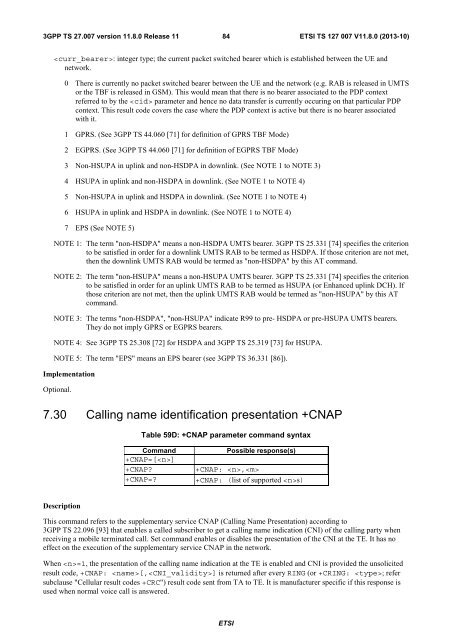ts_127007v110800p
ts_127007v110800p
ts_127007v110800p
Create successful ePaper yourself
Turn your PDF publications into a flip-book with our unique Google optimized e-Paper software.
3GPP TS 27.007 version 11.8.0 Release 11<br />
84<br />
ETSI TS 127 007 V11.8.0 (2013-10)<br />
: integer type; the current packet switched bearer which is established between the UE and<br />
network.<br />
0 There is currently no packet switched bearer between the UE and the network (e.g. RAB is released in UMTS<br />
or the TBF is released in GSM). This would mean that there is no bearer associated to the PDP context<br />
referred to by the parameter and hence no data transfer is currently occuring on that particular PDP<br />
context. This result code covers the case where the PDP context is active but there is no bearer associated<br />
with it.<br />
1 GPRS. (See 3GPP TS 44.060 [71] for definition of GPRS TBF Mode)<br />
2 EGPRS. (See 3GPP TS 44.060 [71] for definition of EGPRS TBF Mode)<br />
3 Non-HSUPA in uplink and non-HSDPA in downlink. (See NOTE 1 to NOTE 3)<br />
4 HSUPA in uplink and non-HSDPA in downlink. (See NOTE 1 to NOTE 4)<br />
5 Non-HSUPA in uplink and HSDPA in downlink. (See NOTE 1 to NOTE 4)<br />
6 HSUPA in uplink and HSDPA in downlink. (See NOTE 1 to NOTE 4)<br />
7 EPS (See NOTE 5)<br />
NOTE 1: The term "non-HSDPA" means a non-HSDPA UMTS bearer. 3GPP TS 25.331 [74] specifies the criterion<br />
to be satisfied in order for a downlink UMTS RAB to be termed as HSDPA. If those criterion are not met,<br />
then the downlink UMTS RAB would be termed as "non-HSDPA" by this AT command.<br />
NOTE 2: The term "non-HSUPA" means a non-HSUPA UMTS bearer. 3GPP TS 25.331 [74] specifies the criterion<br />
to be satisfied in order for an uplink UMTS RAB to be termed as HSUPA (or Enhanced uplink DCH). If<br />
those criterion are not met, then the uplink UMTS RAB would be termed as "non-HSUPA" by this AT<br />
command.<br />
NOTE 3: The terms "non-HSDPA", "non-HSUPA" indicate R99 to pre- HSDPA or pre-HSUPA UMTS bearers.<br />
They do not imply GPRS or EGPRS bearers.<br />
NOTE 4: See 3GPP TS 25.308 [72] for HSDPA and 3GPP TS 25.319 [73] for HSUPA.<br />
NOTE 5: The term "EPS" means an EPS bearer (see 3GPP TS 36.331 [86]).<br />
Implementation<br />
Optional.<br />
7.30 Calling name identification presentation +CNAP<br />
Table 59D: +CNAP parameter command syntax<br />
Command<br />
+CNAP=[]<br />
+CNAP<br />
+CNAP=<br />
Possible response(s)<br />
+CNAP: ,<br />
+CNAP: (list of supported s)<br />
Description<br />
This command refers to the supplementary service CNAP (Calling Name Presentation) according to<br />
3GPP TS 22.096 [93] that enables a called subscriber to get a calling name indication (CNI) of the calling party when<br />
receiving a mobile terminated call. Set command enables or disables the presentation of the CNI at the TE. It has no<br />
effect on the execution of the supplementary service CNAP in the network.<br />
When =1, the presentation of the calling name indication at the TE is enabled and CNI is provided the unsolicited<br />
result code, +CNAP: [,] is returned after every RING (or +CRING: ; refer<br />
subclause "Cellular result codes +CRC") result code sent from TA to TE. It is manufacturer specific if this response is<br />
used when normal voice call is answered.<br />
ETSI


